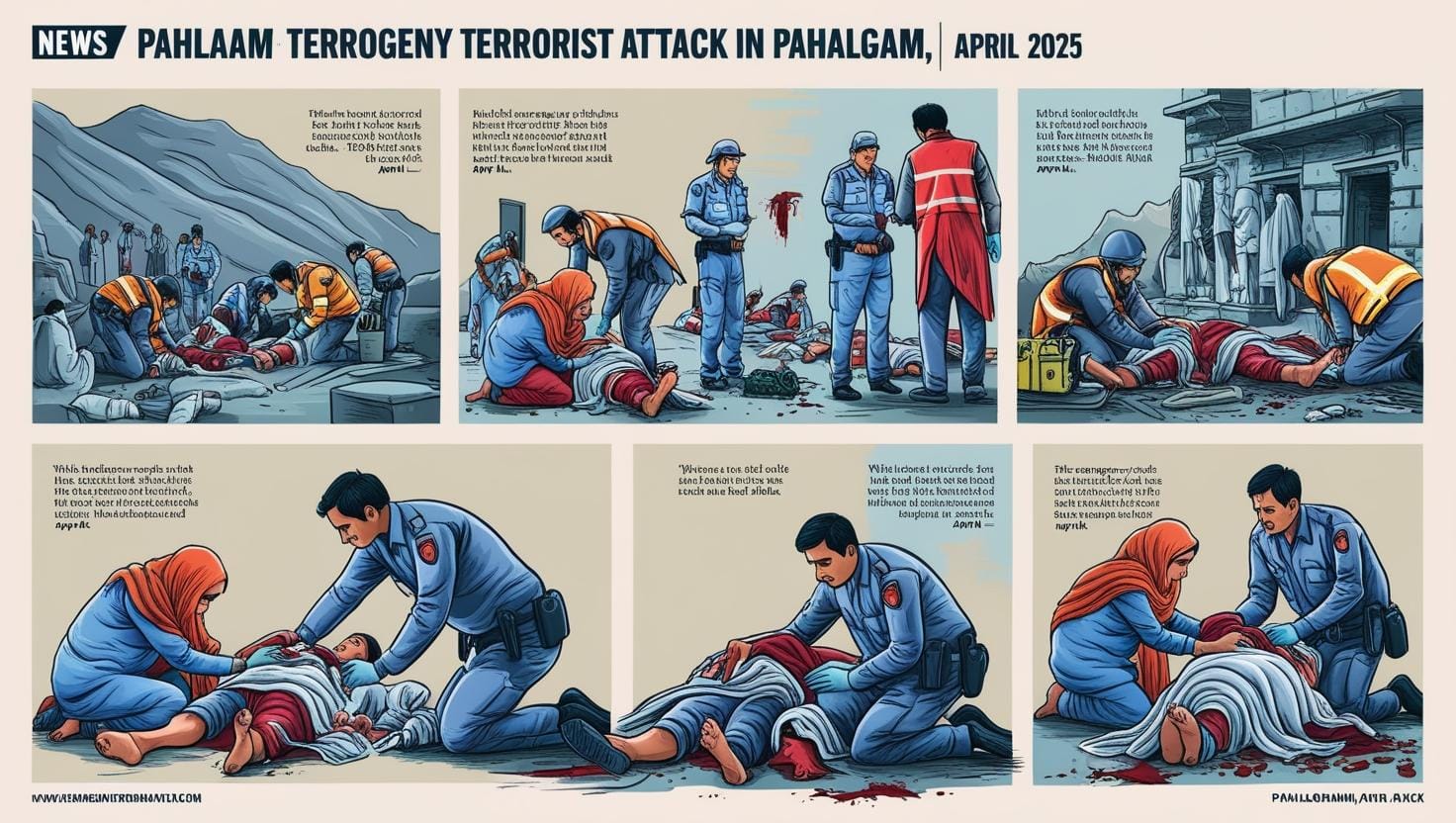
Terror Strikes Pahalgam: April 2025 Attack Leaves India in Shock
As India reels from the shock of yet another senseless act of violence, the Pahalgam attack serves as a grim reminder of the fragile peace in regions marred by decades of conflict. Yet, amid the pain and anger, stories of courage, compassion, and unity continue to emerge—from locals who risked their lives to save the injured, to citizens across the nation lighting candles in solidarity. This is not just a moment to grieve, but a moment to come together as one people—across faiths, states, and political lines—to stand against terror and reaffirm our collective commitment to peace.
Table of Contents
Sr. Headings
- 1. Introduction
- 2. What Happened in Pahalgam?
3. Who Are the Victims?
4. Who Was Behind the Attack?
5. Government Response
6. National and International Reactions
7. Current Security Situation
8. Impact on Kashmir Tourism
9. Conclusion
10. FAQ

Introduction
On April 22, 2025, the scenic valley of Pahalgam in Jammu and Kashmir witnessed a horrifying terror attack, leaving the country in deep mourning. As militants opened fire on innocent tourists, the serenity of the region was shattered.Many survivors described the scene as chaotic and traumatic. “We were taking photos and enjoying the valley when bullets started flying,” said Ravi Kumar, a survivor from Delhi. Locals rushed to help, while others ran for cover in nearby woods. Many were stuck without medical aid for hours due to remote terrain.
What Happened in Pahalgam?
Militants ambushed a group of tourists in Baisaran Valley near Pahalgam, using M4 carbines and AK-47 rifles. The attack killed 28 people, including Indian tourists and foreign nationals, and injured over 20.
In the immediate aftermath:
Emergency services were deployed from Anantnag and Srinagar.
The injured were airlifted to hospitals.
Helplines were set up by the J&K administration for families seeking updates.
Doctors at SKIMS hospital reported critical injuries, mostly bullet wounds. Trauma centers in the valley were overwhelmed.
Who Are the Victims?
Among the deceased were:
Civilians from multiple Indian states
A 26-year-old Navy officer
An Intelligence Bureau official
Tourists from Nepal and UAE
Who Was Behind the Attack?
The Resistance Front (TRF), an offshoot of Lashkar-e-Taiba, has claimed responsibility. The group aims to resist alleged demographic changes in Kashmir.
Why wasn’t the attack prevented despite recent threats by TRF?
How did militants carry heavy weaponry into a tourist zone?
Security analysts believe that either local collaboration or a lapse in monitoring entry routes enabled the attack. Drone surveillance and intelligence-gathering are now being intensified.
Government Response
- PM Modi cut short his Saudi trip and returned to Delhi Home Minister Amit Shah visited Srinagar A joint security operation was launched A helpline was set up for victims and families The ripple effect on Kashmir’s economy is expected to be severe:The region, which was finally seeing post-pandemic recovery, is again under a tourism freeze.April to July is peak tourism season in Pahalgam.Over 25,000 advance bookings have been cancelled in just 24 hours.Local businesses—hotels, shikaras, ponies, guides—will face heavy losses.
National and International Reactions
Widespread condemnation across political parties
EU leaders and the US expressed solidarity with India
Protests and vigils held across several cities
Current Security Situation
This attack, one of the worst in years, has deeply affected tourism confidence. With Pahalgam being a key summer destination, cancellations have surged.Many locals fear backlash and profiling. “We condemn this act. We too want peace. Please don’t see us as terrorists,” said a local hotel owner. Civil society groups are urging calm and unity.


The attackers, affiliated with TRF, reportedly targeted tourists to resist alleged demographic changes in Kashmir.
28 individuals, including Indian and foreign nationals, lost their lives.
A joint operation is underway, but no official confirmation of arrests has been made as of now.
Authorities have increased security across the region, but travelers are advised to stay updated via official channels.
Leaders from the EU, US, and neighboring countries have condemned the attack and expressed support for India.
Conclusion
The Pahalgam attack has left an indelible mark on the nation’s consciousness. It highlights the persistent threat of terrorism and the need for vigilance, solidarity, and a long-term peace strategy.As India reels from the shock of yet another senseless act of violence, the Pahalgam attack serves as a grim reminder of the fragile peace in regions marred by decades of conflict. Yet, amid the pain and anger, stories of courage, compassion, and unity continue to emerge—from locals who risked their lives to save the injured, to citizens across the nation lighting candles in solidarity. This is not just a moment to grieve, but a moment to come together as one people—across faiths, states, and political lines—to stand against terror and reaffirm our collective commitment to peace.

OCP Academy
(A Unit of OCP Foundation)
Learning Today, Leading Tomorrow
Recent Posts
- What’s Holding You Back From the Career You Deserve – Could It Be a Lack of OCP Academy’s Expertise?
- Empowering AI Learning: Community and Collaboration at OCP Academy
- Top 7 Reasons to Choose OCP Academy for Your Digital Marketing Certification in 2025
- Bridging AR and Social Media: How OCP Academy Teaches Creating Interactive Digital Campaigns
- Are You One Skill Away from a Promotion – and Is It the One OCP Academy Teaches?
Archives
Categories
- Admission
- Admissions & Enrollment
- AdTech & MarTech EcoSystem
- Aerospace & Defense Technology
- Agency Growth
- AI in Education
- AI in Marketing
- Animation
- AR content creation
- AR filter training
- AR in advertising
- AR Technology
- AR training institute India
- AR, VR, MR, XR
- Artificial Intelligence
- Artificial Intelligence Education
- Asia-Pacific Security
- Audience Engagement
- Augmented reality trends
- B2B Growth
- B2B Marketing
- Brand Building for Engineers
- Brand Digital Presence & Optimization
- Brand Strategy
- Business & Startups
- Business Expansion
- Business Innovation
- Business Intelligence
- Career & Placement
- Career Advice
- Career Change & Upskilling
- Career Developmen
- Career Development
- Career Growth
- Career Guidance
- Career In Digital Marketing
- Career Skills Development
- Career Transformation
- Case Studies
- Certification Programs
- Certifications
- Chandrayaan
- ChatGPT
- Client Acquisition & Retention
- Client Management
- Client Relationship Management
- Collaborative Learning
- Construction Business
- Consumer Awareness
- Content Marketing
- Content Marketing Insights
- Content Strategy
- Corporate Social Responsibility (CSR)
- Cross-Cultural Communication
- Current Affairs
- Customer Engagement
- Customer Experience
- Customer Journey
- Customer Relationship Management (CRM)
- Cyber Threat Intelligence
- Cybersecurity
- Data Analytics
- Data Science
- Data Science in Marketing
- Data-Driven Marketing
- Database Technologies
- Defense
- Digital Career Readiness
- Digital Careers & Opportunities
- Digital Marketing
- Digital Marketing Courses
- Digital Marketing Education
- Digital Marketing Foundation
- Digital Marketing Freelancing Business
- Digital Marketing Skills
- Digital Marketing Strategies
- Digital marmeting
- Digital Skills Development
- Digital Skills Training
- Digital Transformation
- Digital Trust
- Display Marketing
- Doctor
- E-commerce
- E-Commerce & Online Services
- E-Commerce Management
- E-commerce Marketing
- E-Learning
- E-learning Accreditation
- E-Learning Opportunities
- E-learning Platforms
- Eco-Friendly Business Practices
- Editorial & Opinion
- EdTech
- EdTech Industry Insights
- EdTech Reviews
- EdTech Training Programs
- EdTech Trends
- Education
- Education & Learning
- Education Marketing
- Education Sector Insights
- Education Technology
- Education Technology (EdTech)
- Education,
- Educational Institutions
- Effective Email Marketing
- Email Marketing
- Email Marketing Techniques
- Emerging Technologies for Digital Marketing
- Engineering Business
- Engineering Innovations
- Entertainment
- Entertainment Branding
- Entertainment Marketing
- Entrepreneurship
- Entrepreneurship & Digital Growth
- Environment & Climate
- Farming & Agriculture
- Film Industry
- Film Industry Insights
- Film Marketing
- Freelancer Marketing Tips
- Freelancing
- Fundamentals of Social Media
- Future of Business
- Future of Digital Marketing
- Future Trends
- Gambling
- Geopolitics
- Global Marketing
- Green Technology
- Growth Hacking for Apps
- Growth Marketing
- Healthcare Marketing
- Human Rights & Conflict
- iGaming
- Immersive Technologies
- Impact of COVID-19
- Inbound Marketing
- India
- India-Pakistan Relations
- India’s Armed Forces
- Indian
- Indian Defense
- Indigenous Defense Development
- Industry Case Studies
- Industry Insights
- Industry-Relevant Training
- Influencer Marketing
- Information Security News
- Information Technology
- Infrastructure
- Intelligence and Espionage
- Interactive user experience
- International Business
- International Defense Cooperation
- Internship
- IT Industry Insights
- IT Jobs & Careers
- Jammu & Kashmir
- JOB
- Job-Oriented Courses
- Jobs
- Kashmir Conflict
- kasyno online automaty
- Lead Generation
- Lifelong Learning
- local business
- Local Business Growth
- local SEO
- Local SEO for Schools
- Local SEO Strategies
- Manufacturing
- Marketing Automation
- Marketing Certifications
- Marketing Courses in India
- Marketing Education
- Marketing for Institutions
- Marketing Leadership Programs
- Marketing Metrics & KPIs
- Marketing Strategies
- Marketing Strategy
- Marketing Technology
- Marketing Technology (MarTech)
- Marketing Tools
- Marketing Trends
- Marketing Trends 2025
- Media & Broadcasting
- Media & Entertainment
- Mentorship
- Mentorship in Tech
- Mentorship Programs
- Meta Spark AR learning
- Military Operations
- Military Strategy
- Military Technology
- Missile Technology
- Mobile App Marketing
- Mobile Apps & Innovation
- Mobile Commerce
- Mobile Tools
- Movie Promotions
- National News
- National Security
- new
- News Industry Trends
- OCP Academy
- OCP Academy courses
- OCP Academy Insights
- Off-Site SEO
- On-Site SEO
- Online Advertising
- Online Branding
- Online Courses
- Online Digital Marketing Certificate Programs
- Online Journalism
- Online Learning
- Online Learning Platforms
- Online Learning Programs
- online marketing
- Online Reputation Management
- Online Safety & Scams
- Parent Engagement
- Parenting & Technology
- Performance Marketing
- Personal Development
- Politics & Policy
- Post Graduate Digital Marketing Course
- PPC Ads
- Professional Certification
- Professional Development
- Professional Growth
- Professional Training & Certification
- Professional Training Programs
- Ratan Tata
- Real-time user engagement
- Real-World Applications
- Realstate
- Reel
- Remote Client Management
- Sales
- School Growth Strategies
- Search Engine Marketing
- Search Engine Optimization
- SEO
- SEO & Search Marketing
- SEO & Search Strategy
- SEO for Engineers
- shopkeeper
- Shorts
- Skill Development
- Skill Enhancement
- Skill-Based Learning
- Skills Development
- Small Business
- Small business growth
- Small Business Tips
- Snapchat Lens Studio tutorials
- Social Media
- Social Media Engagement
- Social media innovation
- Social Media Marketing
- Social Media Strategy
- South Asia
- South Asian Security
- Space Science
- Startup Hub
- Startup India
- Startup Marketing
- Stock Market
- Student Resources
- Student Success Stories
- Sustainability
- Tech-Driven Careers
- Technology
- Technology in Media
- Technology Trends
- Terrorism & Security
- The Path to Digital Journey
- Tourism & Economy
- Trending Technologies 2025
- Uncategorized
- Urban Mobility
- User Experience (UX)
- Video Marketing
- Visual storytelling with AR
- Web Analytics & Metrics
- Web Design
- Workshop Highlights & Webinars
- XR in marketing
- YouTube




